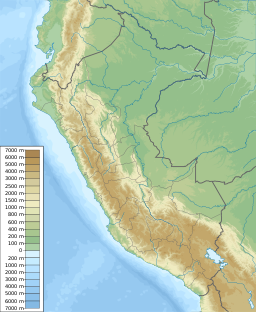| Lake Aricota | |
|---|---|
 | |
 | |
| Location | Candarave Province, Tacna Region, Peru |
| Coordinates | 17°21′36″S 70°17′37″W / 17.36000°S 70.29361°W / -17.36000; -70.29361 |
| Type | Landslide lake |
| Primary inflows | Callazas River, Jaruma Creek |
| Primary outflows | Curibaya River |
| Basin countries | Peru |
| Water volume | 140 cubic kilometres (34 cu mi) |
| Surface elevation | 2,800 metres (9,186 ft) |
Lake Aricota (possibly from Aymara ari pointed, sharp, quta lake) is a lake in Candarave Province, region of Tacna, Peru. It has an elevation of 2,800 metres (9,186 ft) above sea level.
Geography
The lake originated when debris flows in steep canyon walls dammed the Callazas River. The waters of the lake are currently diverted to a hydroelectric plant, which has lowered the lake level from ~800.000 m in 1967 to a monthly average of 140.000 m in 2000. Main inflow sources of the lake are the Callazas River and the Jaruma creek. The main outflow is due to seepage through the debris dam to the Curibaya River (although hydroelectric use could count also).
Waters of Lake Aricota have a high arsenic content as the waters of Callazas River and Salado River (a tributary of Jaruma Creek) pass through the Yucamane volcanic area.
See also
References
- ^ Peru 1:100 000, Tarata (35-v). IGN (Instituto Geográfico Nacional - Perú).
- ^ Placzek, Christa; Quade, Jay; Betancourt, Julio (2001). "Holocene Lake-Level Fluctuations of Lake Aricota, Southern Peru". Quaternary Research. 56: 181–190. doi:10.1006/qres.2001.2263.
- ^ "Laguna de Aricota". Inventario Turistico del Perú (in Spanish). MINCETUR. Retrieved 2016-08-17.
- Radio San Gabriel, "Instituto Radiofonico de Promoción Aymara" (IRPA) 1993, Republicado por Instituto de las Lenguas y Literaturas Andinas-Amazónicas (ILLLA-A) 2011, Transcripción del Vocabulario de la Lengua Aymara, P. Ludovico Bertonio 1612 (Spanish-Aymara-Aymara-Spanish dictionary)
- Murcott, Susan (2012). Arsenic Contamination in the World: An International Sourcebook 2012. IWA Publishing. p. 42. ISBN 9781780400389.
This Tacna Region geography article is a stub. You can help Misplaced Pages by expanding it. |